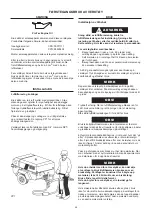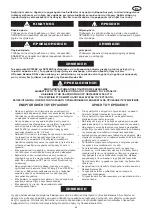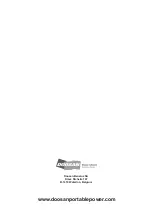
56
ASSEMBLY OF THE DCT40BV AND DCT40BS PAVING BREAKERS
GENERAL INSTRUCTIONS
• Before assembly of the breaker, clean all parts thoroughly
and lubricate surfaces with a thin film of recommended oil
(see Lubrication).
• Apply a film of O-ring lubricant to all O-rings before final
assembly.
• It is recommended that the assembling of the nozzle (2)
and the cushion bushing (33) should be carried out by the
manufacturer or authorised distributor.
• The existence of a piston air cushion should be
determined. Hold the cylinder vertically and allow the
piston to drop down the bore small diameter first. An air
cushion is present if the piston “bounces” at the bottom of
the cylinder and no metal to metal contact noise can be
heard. If a cushion is not present contact your authorised
Doosan Benelux SA repair centre for advice.
CYLINDER ASSEMBLY
Grip the cylinder (1) vertically in a vice protected with leather
or copper covered vice jaws.
Lubricate and insert the piston (4) small end first into the
bore. – Check for cushion.
Lubricate and slide the valve ring (34) onto the cylinder (1)
and replace valve cover (31).
Position the valve spacer (30) on top of the valve cover (31).
Replace the sealing ring (28).
HANDLE ASSEMBLY
For BV models only:
If the handle stop (14) was removed during disassembly it
should be replaced with a new part as the retaining feature is
severed on removal. Locate the stop in the hole in the handle
and tap sharply into place using a soft drift and hammer.
If the hand grip rubbers (10) have been removed these
should now be replaced. Lubricate the inside of the rubber
with soapy water and slide the new rubber into position.
Assemble left and right hand, hand grips (8 and 9), trigger (7)
together with sleeve (13), lubricate around the pivot area and
position the subassembly along the slot in handle body (5).
Note it is usual to position the trigger lever on the same side
as the air inlet of the handle body.
Locate the handle springs (11) between hand grips and
handle body and fix the assembly in place by drifting or
pressing in handle pivot pin (12).
Lubricate the trigger pin (15), trigger ball (16) and replace in
the air inlet connection of the handle body.
Note the trigger pin has a reduced diameter which is placed
next to the trigger ball.
Locate the trigger spring (17) on top of the trigger ball. Apply
thread retainer (loctite 243, or similar) on the thread of the
inlet bushing (18) and tighten to 200 Nm (147 lb.ft) torque.
Check that the handles and trigger move freely.
For BS models only:
If the handle bar has been disassembled from the handle
body. Securely support the handle body (42) beneath a press
and position the handle bar (43) in the mating body hole.
Note: Ensure that the handle bar has the correct orientation
and alignment to accept the trigger pin (45) when pressed
home.
Press home the handle bar to depth until the lock pin-hole is
aligned.
Press or drift in the lock spring pin.
Lubricate and replace the trigger pin (46). Note the trigger pin
has a reduced diameter which is placed next to the trigger
ball.
Check that the trigger pin can move freely.
Position the trigger lever (44) and secure in place with spring
pin (45).
Lubricate the trigger pin (46), trigger ball (16) and replace in
the air inlet connection of the handle body.
Note the trigger pin has a reduced diameter which is placed
next to the trigger ball.
Locate the trigger spring (17) on top of the trigger ball. Apply
thread retainer (loctite 243, or similar) on the thread of the
inlet bushing (18) and tighten to 200 Nm (147 lb.ft) torque.
Check that the trigger moves freely.
Lubricate the inside of the handle grip rubber with soapy
water and slide the new rubber into position.
MAIN DISASSEMBLY
Lightly grip the cylinder assembly vertically in a vice and
position the handle assembly in place.
Note that it is usual to orientate the trigger lever and air inlet
180 degrees from the fronthead bolt groove in the cylinder.
Replace the four handle screws (26) use new handle nuts
(27) and tighten down evenly to a torque of 90 Nm (66.4 lb.ft)
torque.
Remove the cylinder and handle assembly from the vice.
Replace muffler (29) on the assembly by tapping the muffler
fully home using a hide mallet.
FRONT HEAD ASSEMBLY
Apply a coating of grease then replace spring (21) and
plunger (20) in position in fronthead (3).
Position the latch (6) in its slot and secure in place by drifting
or pressing in outer spring pin (23). Position then press or
drift home inner spring pin (22).
Replace fronthead assembly onto cylinder and aligning pinch
bolt hole with the cylinder groove.
Replace pinch bolt (24) and nut (25) and tighten a torque of
200 Nm (147 lb.ft) torque.
ASSEMBLY CHECKS
Following service the breaker should be checked for correct
operation prior to being released back to the job site.
Fit the correct size accessory into the breaker and connect to
an airline. Using air at low pressure 2 bar (30 psi), check that
the breaker is free from air leaks around the inlet connection
and that the breaker does not automatically start to operate
without the trigger being depressed.
Increase the air pressure to 6 bar (90 psi) and run the tool
in short bursts to check the tool operates correctly and stops
and starts cleanly without hesitation.
Breaker operating frequency should be 960 blows per
minute and air consumption 1.85m3/min (60 CFM) at 6 bar
(90 psi) air pressure.
Содержание DCT40BS
Страница 59: ...59 ...
Страница 60: ...Doosan Benelux SA Drève Richelle 167 B 1410 Waterloo Belgium www doosanportablepower com ...





































